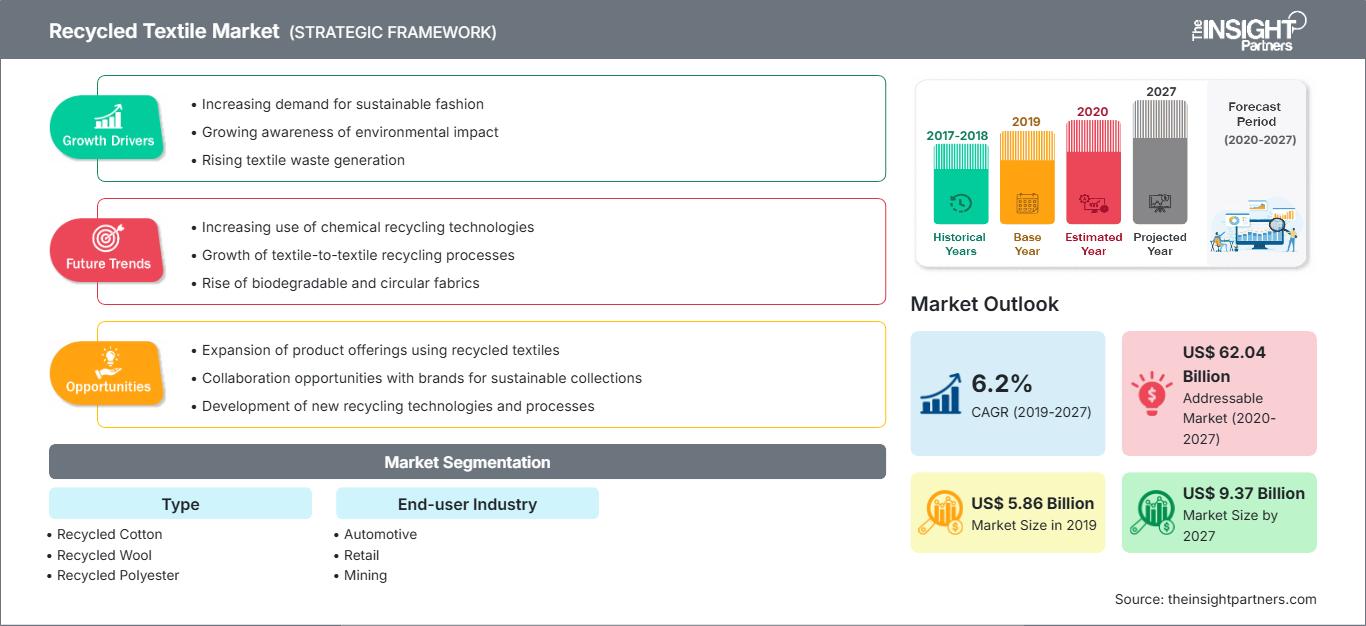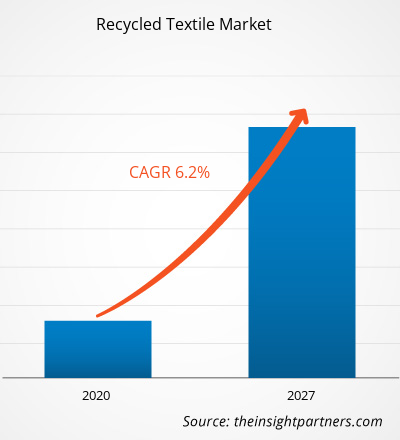El mercado de textiles reciclados se valoró en US$ 5.855,39 millones en 2019 y se proyecta que alcance los US$ 9.365,04 millones en 2027; se espera que crezca a una CAGR de 6,2% de 2020 a 2027.
Los textiles reciclados son prendas de vestir viejas u otros textiles sin usar que pueden recuperarse para su reutilización o recuperación de materiales. En los últimos años, ha aumentado la preocupación por la eliminación de residuos textiles a nivel mundial, lo que puede afectar negativamente al medio ambiente. La demanda de textiles reciclados está en aumento a nivel mundial, con un aumento repentino en diversas industrias de uso final, como la confección, los tejidos, la automoción y otras. Los fabricantes reciclan los textiles usados para obtener mejores productos, que podrían utilizarse en diversas industrias de uso final y han adoptado diversas tecnologías. El reciclaje de recursos puede realizarse principalmente mediante técnicas térmicas, mecánicas y químicas.
Europa se ha convertido en un importante mercado de textiles reciclados debido al aumento de las iniciativas gubernamentales en la región. Además, la creciente demanda de productos textiles reciclados en la industria automotriz ofrece una oportunidad lucrativa para los actores del mercado. El aumento del poder adquisitivo, junto con el cambio en el estilo de vida, es uno de los principales factores impulsores del crecimiento del mercado textil en la región europea. En Europa, casi el 15% de la ropa usada por el consumidor se recicla, mientras que más del 75% de la ropa pre-utilizada es reciclada por los fabricantes para usos industriales. La demanda de textiles reciclados en Europa está creciendo a un ritmo acelerado en los últimos años. Los productores de textiles reciclados se están centrando en países como Alemania, Reino Unido, etc., lo que ha generado una gran demanda de textiles reciclados en la región. También se espera que el creciente enfoque del consumidor hacia una economía textil circular impulse en mayor medida el crecimiento del mercado en la región.
Estados Unidos, Brasil, India, Rusia, Sudáfrica, México, España y el Reino Unido se encuentran entre los países más afectados en términos de casos confirmados y muertes reportadas hasta agosto de 2020. La COVID-19 ha afectado las economías e industrias en varios países debido a confinamientos, prohibiciones de viaje y cierres comerciales. La industria química y de materiales global es una de las principales industrias que sufren graves interrupciones, como interrupciones en la cadena de suministro e interrupciones en la fabricación debido al brote de COVID-19. Por ejemplo, China es el centro mundial de fabricación y el mayor proveedor de materia prima para varias industrias. El confinamiento de varias plantas y fábricas en China y regiones líderes como Asia Pacífico y Europa está afectando las cadenas de suministro globales e impactando negativamente la fabricación, los cronogramas de entrega y las ventas de varios bienes. Todos estos factores han afectado enormemente al mercado global de textiles reciclados.
Personalice este informe según sus necesidades
Obtendrá personalización en cualquier informe, sin cargo, incluidas partes de este informe o análisis a nivel de país, paquete de datos de Excel, así como también grandes ofertas y descuentos para empresas emergentes y universidades.
Mercado de textiles reciclados: Perspectivas estratégicas

- Obtenga las principales tendencias clave del mercado de este informe.Esta muestra GRATUITA incluirá análisis de datos, desde tendencias del mercado hasta estimaciones y pronósticos.
Perspectivas del mercado
Crecientes preocupaciones relacionadas con la eliminación de residuos textiles
El mecanismo de fabricación textil se considera uno de los procesos con uso intensivo de sustancias químicas que genera un alto volumen de residuos textiles a lo largo de sus operaciones. Estos residuos pueden clasificarse en dos grupos: residuos textiles preconsumo y residuos textiles posconsumo. El aumento de la cantidad de residuos textiles supone una carga para el medio ambiente y genera el problema de su eliminación o incineración efectiva en los vertederos existentes. Según una estimación, aproximadamente entre el 10 % y el 20 % de todos los productos textiles no utilizados se consideran residuos. Por ejemplo, según la EPA de EE. UU., en 2015 se generaron 15,75 millones de toneladas de textiles como residuos sólidos urbanos, de los cuales el 19 % se incineró y el 65 % terminó en vertederos. Además, un informe de la Agencia de Protección Ambiental de EE. UU. sugiere que la producción y la eliminación de textiles generan emisiones de gases de efecto invernadero. Además, el proceso de incineración emite sustancias orgánicas como metales pesados, dioxinas, gases ácidos y partículas de polvo, que se consideran perjudiciales tanto para los seres humanos como para el medio ambiente. Además, la eliminación de cenizas residuales se ha convertido en un problema grave, ya que contienen una alta concentración de materiales tóxicos. Por lo tanto, es fundamental gestionar eficazmente los residuos textiles mediante métodos de reutilización o reciclaje, lo que podría promover la sostenibilidad ambiental. En estas situaciones, el reciclaje de residuos textiles se considera una alternativa viable que ayuda a reducir la carga sobre los recursos naturales, minimiza la necesidad de espacio en vertederos y contribuye al ahorro de energía. Además, las estrictas leyes gubernamentales que regulan la gestión eficaz de los residuos textiles tienen como objetivo promover el reciclaje textil como una alternativa sostenible para abordar el problema inminente de los residuos.
Información sobre tipos
Según el tipo, el mercado de textiles reciclados se segmenta en algodón reciclado, lana reciclada, poliéster reciclado, nailon reciclado y otros. Se espera que el segmento del nailon reciclado crezca a su ritmo más rápido durante el período de pronóstico de 2019 a 2027. El nailon reciclado se fabrica a partir de plásticos industriales, fibras de desecho, desechos de tejedurías y redes de pesca posconsumo. Estos desechos se regeneran en nailon nuevo, que tiene la misma calidad que el nailon virgen. Las bolsas, telas y alfombras de nailon también se convierten en nailon reciclado para su posterior uso. Una gran proporción del nailon reciclado proviene de las redes de pesca. Representa una excelente solución para desviar la basura oceánica. Reciclar nailon es un proceso costoso en comparación con el nailon, pero ofrece muchos beneficios ambientales. Al reciclar nailon, se pueden eliminar los desechos y reducir la cantidad de emisiones de gases de efecto invernadero en la fabricación. Disminuye la dependencia del petróleo como fuente de materia prima. El uso de nailon reciclado también ayuda a promover nuevas fuentes de reciclaje para productos de nailon que ya no se utilizan. La mayoría de los materiales reciclados mecánicamente se funden a altas temperaturas, lo que destruye los contaminantes y los transforma en formas reutilizables. El nailon se funde a bajas temperaturas durante el reciclaje, dejando residuos contaminantes. Por lo tanto, el nailon debe limpiarse cuidadosamente antes de reciclarlo.
Perspectivas de la industria para el usuario final
Según la industria del usuario final, el mercado del material reciclado se segmenta en automoción, comercio minorista, minería, etc. Se espera que el segmento automotriz crezca a su ritmo más rápido durante el período de pronóstico de 2019 a 2027. Los textiles reciclados se utilizan en la industria automotriz y tienen una gran contribución en la producción de componentes para automóviles. El uso de textiles reciclados en aplicaciones automotrices incluye componentes visibles como revestimientos de pisos, tapicería y cinturones de seguridad, así como textiles reciclados ocultos como tubos y cintas, cables para neumáticos, componentes de airbags y fibras. Los textiles reciclados se utilizan en la industria automotriz debido a su resistencia a la tracción, abrasión, permeabilidad al aire, resistencia a la compresión, elasticidad, facilidad de limpieza, resistencia al fuego y resistencia a condiciones climáticas dinámicas. El algodón reciclado se utiliza en el relleno de asientos o el aislamiento de automóviles.
Anandi Enterprises, Chindi, Khaloom Textile India Pvt. Ltd. y Kishco Group, entre otras, son actores clave en el mercado global de textiles reciclados. Estas empresas están implementando estrategias de desarrollo de nuevos productos, fusiones y adquisiciones para ampliar su cartera de clientes y obtener una cuota de mercado significativa a nivel mundial, lo que les permite mantener su marca a nivel global.
Perspectivas regionales del mercado de textiles reciclados
Los analistas de The Insight Partners han explicado detalladamente las tendencias regionales y los factores que influyen en el mercado de textiles reciclados durante el período de pronóstico. Esta sección también analiza los segmentos y la geografía del mercado de textiles reciclados en América del Norte, Europa, Asia Pacífico, Oriente Medio y África, y América del Sur y Central.
Alcance del informe de mercado de textiles reciclados
| Atributo del informe | Detalles |
|---|---|
| Tamaño del mercado en 2019 | 5.860 millones de dólares estadounidenses |
| Tamaño del mercado en 2027 | US$ 9.37 mil millones |
| CAGR global (2019-2027) | 6,2% |
| Datos históricos | 2017-2018 |
| Período de pronóstico | 2020-2027 |
| Segmentos cubiertos | Por tipo
|
| Regiones y países cubiertos | América del norte
|
| Líderes del mercado y perfiles de empresas clave |
|
Densidad de actores del mercado de textiles reciclados: comprensión de su impacto en la dinámica empresarial
El mercado de textiles reciclados está creciendo rápidamente, impulsado por la creciente demanda del usuario final debido a factores como la evolución de las preferencias del consumidor, los avances tecnológicos y un mayor conocimiento de los beneficios del producto. A medida que aumenta la demanda, las empresas amplían su oferta, innovan para satisfacer las necesidades del consumidor y aprovechan las tendencias emergentes, lo que impulsa aún más el crecimiento del mercado.

- Obtenga una descripción general de los principales actores clave del mercado de textiles reciclados
Informe destacado
- Las tendencias progresivas de la industria en el mercado global de textiles reciclados ayudan a los actores a desarrollar estrategias efectivas a largo plazo.
- Estrategias de crecimiento empresarial adoptadas por los mercados desarrollados y en desarrollo
- Análisis cuantitativo del mercado mundial de textiles reciclados de 2017 a 2027
- Estimación de la demanda mundial de textiles reciclados en diversas industrias
- Análisis PEST para ilustrar la eficacia de los compradores y proveedores que operan en la industria para predecir el crecimiento del mercado
- Desarrollos recientes para comprender el escenario competitivo del mercado y la demanda global de textiles reciclados
- Tendencias y perspectivas del mercado junto con los factores que impulsan y restringen el crecimiento del mercado mundial de textiles reciclados
- Proceso de toma de decisiones mediante la comprensión de las estrategias que sustentan el interés comercial con respecto al crecimiento del mercado mundial de textiles reciclados
- Tamaño del mercado global de textiles reciclados en varios nodos del mercado.
- Descripción detallada y segmentación del mercado global de textiles reciclados, así como su dinámica en la industria.
- Tamaño del mercado mundial de textiles reciclados en varias regiones con prometedoras oportunidades de crecimiento
Mercado mundial de textiles reciclados, por tipo
- Algodón reciclado
- Lana reciclada
- poliéster reciclado
- Nailon reciclado
- Otros
Mercado mundial de textiles reciclados, por industria de usuario final
- Automotor
- Minorista
- Minería
- Otros
Perfiles de empresas
- Empresas Anandi
- Chindi
- Khaloom Textile India Pvt. Ltd.
- Grupo Kishco
- Usha Yarns Limited
- Corporación Hyosung
- Fibras Leigh Inc.
- Corporación Martex Fiber Southern
- Renewcell AB
- Grupo Boer
- Análisis histórico (2 años), año base, pronóstico (7 años) con CAGR
- Análisis PEST y FODA
- Tamaño del mercado, valor/volumen: global, regional y nacional
- Industria y panorama competitivo
- Conjunto de datos de Excel
Informes recientes
Testimonios
Razón para comprar
- Toma de decisiones informada
- Comprensión de la dinámica del mercado
- Análisis competitivo
- Información sobre clientes
- Pronósticos del mercado
- Mitigación de riesgos
- Planificación estratégica
- Justificación de la inversión
- Identificación de mercados emergentes
- Mejora de las estrategias de marketing
- Impulso de la eficiencia operativa
- Alineación con las tendencias regulatorias




















 Obtenga una muestra gratuita para - Mercado de textiles reciclados
Obtenga una muestra gratuita para - Mercado de textiles reciclados